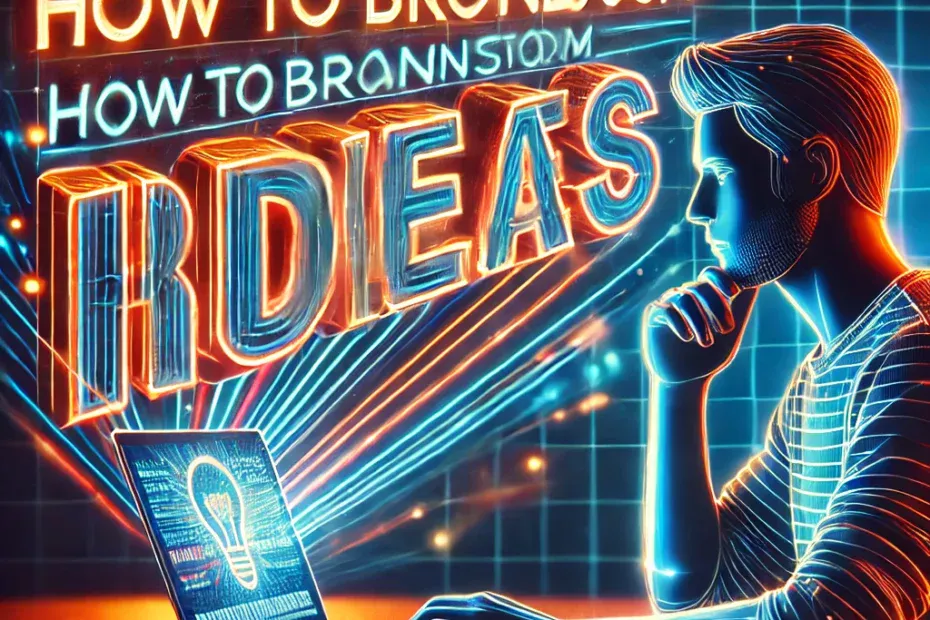How to Brainstorm Ideas? Brainstorming is a crucial part of the creative process, whether you’re developing new content for your blog, planning a marketing campaign, or solving a complex problem. Effective brainstorming can lead to innovative ideas and solutions. This guide will walk you through the steps to brainstorm ideas effectively.
Why Brainstorm Ideas?
- Generate Creative Solutions: Unlock creative and out-of-the-box thinking.
- Encourage Collaboration: Foster teamwork and idea sharing.
- Solve Problems: Develop solutions for challenges you’re facing.
- Enhance Productivity: Streamline the idea-generation process.
- Boost Innovation: Stay ahead of the competition with fresh, innovative ideas.
How to Brainstorm Ideas : Steps to Brainstorm Ideas
1. Set Clear Objectives
Before starting the brainstorming session, establish clear objectives. What problem are you trying to solve, or what ideas are you looking to generate? Clear objectives keep the session focused and productive.
2. Create the Right Environment
The environment plays a crucial role in fostering creativity. Ensure the space is comfortable, well-lit, and free from distractions. Encourage an open and supportive atmosphere where all ideas are welcomed without judgment.
3. Choose the Right Team
Select a diverse group of participants with different perspectives and expertise. A diverse team brings varied viewpoints and can lead to more innovative ideas. Ensure everyone feels comfortable sharing their thoughts.
4. Use Brainstorming Techniques
Different techniques can help spark creativity and generate a wide range of ideas. Here are some effective brainstorming techniques:
- Mind Mapping: Create a visual representation of ideas, starting with a central concept and branching out into related topics.
- Brainwriting: Participants write down their ideas independently before sharing them with the group.
- SCAMPER: Use the SCAMPER technique (Substitute, Combine, Adapt, Modify, Put to another use, Eliminate, Reverse) to explore different angles and possibilities.
- SWOT Analysis: Analyze Strengths, Weaknesses, Opportunities, and Threats related to your objective.
- Role Storming: Participants take on different roles or perspectives to generate ideas.
- Round Robin: Go around the group, allowing each person to contribute one idea at a time.
5. Encourage Free Thinking
Encourage participants to share all ideas, no matter how unconventional or impractical they may seem. Free thinking can lead to unexpected and innovative solutions. Avoid criticizing or dismissing ideas during the brainstorming session.
6. Build on Ideas
Build on the ideas generated during the session. Encourage participants to expand on others’ ideas, combining and refining them to create more robust solutions. Collaboration often leads to the best outcomes.
7. Record All Ideas
Document all ideas generated during the brainstorming session. Use whiteboards, sticky notes, or digital tools to capture every thought. Recording ideas ensures nothing is forgotten and allows for further analysis and refinement later.
8. Evaluate and Prioritize
After the brainstorming session, evaluate and prioritize the ideas based on criteria such as feasibility, impact, and alignment with your objectives. Narrow down the list to the most promising ideas that can be developed further.
Best Practices for Effective Brainstorming
- Set a Time Limit: Keep the session focused by setting a time limit. Aim for 30-60 minutes to maintain energy and productivity.
- Encourage Participation: Ensure everyone has an opportunity to contribute. Use techniques like round robin to involve quieter participants.
- Stay Positive: Maintain a positive and supportive atmosphere. Avoid criticism and judgment during the idea-generation phase.
- Facilitate the Session: Assign a facilitator to guide the session, keep it on track, and ensure objectives are met.
- Follow Up: After the session, follow up with participants to discuss the selected ideas and next steps.
Common Mistakes to Avoid
- Lack of Focus: Ensure the session has a clear objective to avoid wandering off-topic.
- Domination by Few: Prevent a few participants from dominating the session. Encourage equal participation.
- Negative Atmosphere: Avoid criticism or negative comments that can stifle creativity.
- Ignoring Ideas: Ensure all ideas are considered and documented, even if they seem impractical initially.
- Skipping Evaluation: Don’t skip the evaluation and prioritization phase. It’s crucial to narrow down and select the best ideas for implementation.
Conclusion
Effective brainstorming is essential for generating creative ideas and solving problems. By setting clear objectives, creating the right environment, choosing the right team, using various brainstorming techniques, encouraging free thinking, building on ideas, recording all ideas, and evaluating and prioritizing them, you can make your brainstorming sessions productive and fruitful. Follow best practices and avoid common mistakes to ensure a successful brainstorming process.
For more tips on blogging and SEO, visit wpbloggingtips.com.

